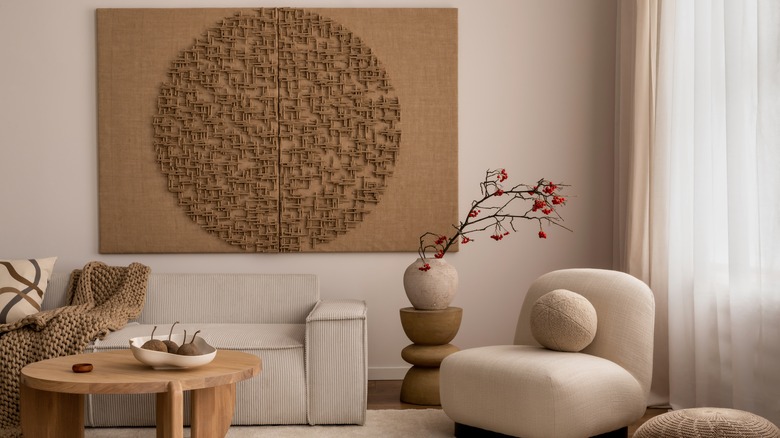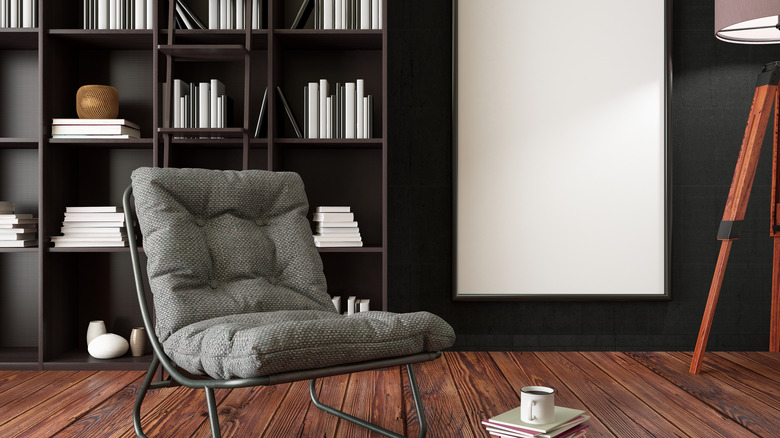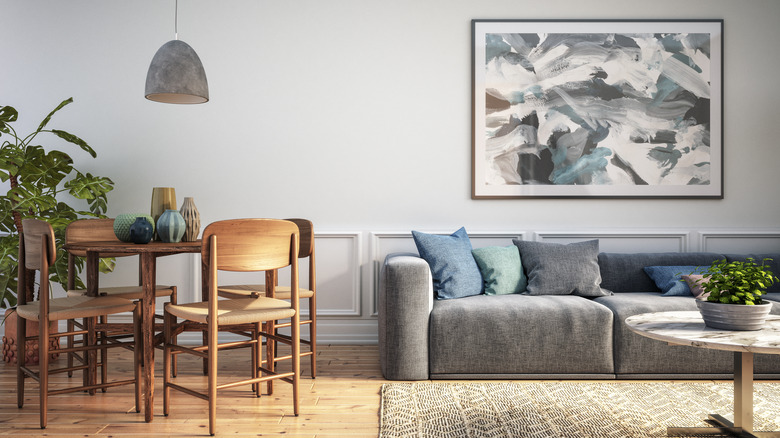The Rule Of Thumb To Keep In Mind When Hanging Extra-Large Artwork
Extra large artwork brings a massive punch to any room. Whether you choose a minimalist, textured design or a colorful abstract piece, the end result is the same: Your eye has a focal point to gravitate toward. But how do you properly hang such a piece? Some people like to hang their artwork intuitively, hammering in a nail at whatever height they think looks best. While this can give you great results, sometimes hanging certain pieces is hard to figure out. No matter which height you hang it, it feels somewhat off. If you're in this predicament with your oversized canvas, then the best thing to do is hang it at least 1 foot from the ground. This ensures there is enough negative space on the bottom, which will negate the risk of the artwork looking like it's about to sit on the floor.
Oversized artwork is anything that is 120 inches tall, or in other words, 10 feet tall. It is often reserved for rooms with taller ceilings to prevent the space from feeling crowded, but since it's so large, you don't have to worry about it hanging perfectly at eye level. Traditionally, you want to hang paintings at the wall's midpoint, which typically falls at 57 inches from the floor to the painting's center point. But large canvases have different rules. Here's a closer look into why.
Why you should hang oversized paintings a foot from the ground
The one-foot rule not only ensures there is enough negative space between the floor and the canvas, but it can also help with hanging the painting in a way that will be easy to consume. The reason we hang smaller art pieces 57 inches from the ground is so they can be at eye level. This number changes depending on how the art piece will be consumed. For example, if you're hanging it in a seating area, the midpoint shifts to 44 inches since folks will take in the art from a lower vantage point. So, when it comes to large artwork, ideally, you would like the first third of the painting to be at eye level to prevent people from having to crane their necks to take it in. That is why hanging it lower to the ground is better.
However, depending on how large it actually is and how tall your ceilings are, you might not always be able to achieve that 1/3 rule. In that case, hanging it one foot from the ground should put you pretty close to that range while also leaving enough breathing room between the installation and the floor. Going lower than that can make it seem like it's horning in on the baseboards, which can make it feel off.
How to hang it above furniture
Hanging oversized canvases over furniture can be tricky. You will need tall ceilings in order to ensure it doesn't crowd the top of the room, which would make it feel too large for the space. However, if you have soaring ceilings or live in a loft-type space, anchoring large paintings over your furniture can create an impressive visual impact. There are several rules to keep in mind when doing so to ensure the setup doesn't look awkward. First, make sure your painting is scaled to the furniture it's floating above. Ideally, it should be about 2/3 the width of the furniture it's being hung over. This ensures it doesn't look too skinny and like it's out of place.
To anchor it to the furniture underneath, aim to float the piece 6 to 12 inches above the table or couch you're putting it over. This helps the two items feel connected without being overly cramped or spaced apart. Any lower and the painting will feel like it's falling onto the furniture, and any higher and the two items won't feel connected. You can also aim for the painting top to be no closer than a foot from the ceiling. This mimics the original tip, and allows for there to be enough breathing room between the painting and the top of the room.


